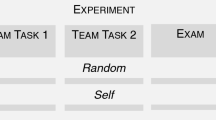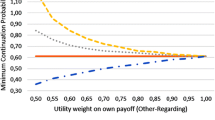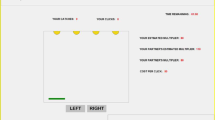Abstract
An important question when assigning individuals to groups concerns the benefits and drawbacks of homogeneity and heterogeneity with respect to the group members’ ability levels. We design a laboratory experiment, in which we assume that the output is just the sum of the group members’ performances. This allows us to isolate the impact of ability-based matching principles on the degree of moral hazard. In line with theories on team cohesion, we find that the degree of moral hazard is larger in heterogeneous groups. As the incentive structure is the same, this can exclusively be attributed to motivational effects. We consider two settings, one where the roles to high- and low-productivity levels are randomly assigned, and one where those roles are earned. Results are robust with respect to these two role assignments.


Similar content being viewed by others
Notes
The belief was incentivized with the following formula: payoff = 20 Taler * (1 − |R − r|), where R represents the subject’s belief about the average participant behavior (percental change of effort reduction in teams compared to individual effort decision and r represents the actual participant behavior (see Appendix C for descriptive statistics)).
We fully acknowledge that our group setting deviates from Moral hazard in team (based on Alchian and Demsetz 1972; Newhouse 1973; Holmström 1982). Of course, as our production function is additively-separable, one could easily implement separate piece rates, thereby eliminating the free-rider problem. However, we preferred not to use a production function with positive cross partial derivates as the decision that maximize individual payments are then interdependent, which makes identifiably a far more difficult issue.
Correlations between APM-test scores and optimal optima are positive by 0.102 (p-value 0.16) and 0.081 (p-value 0.26) for high- and low-types, respectively. However, as both correlations are not significant, the claim that this experimental setup allows for a clear-cut distinction of ability (or productivity) and effort cannot be rejected.
The full sample of elicited variables can be extracted from the instructions.
P-values of the Wilcoxon rank-sum test for relative (to the benchmark of individual effort decision) effort reduction are 0.014 and 0.017 for high- and low-types, respectively.
We are grateful to an anonymous referee for pointing to this explanation.
P-values of the Wilcoxon rank-sum test for relative (to the benchmark of individual effort decision) effort reduction are 0.069 and 0.105 for high- and low-types, respectively.
References
Alchian, A. Armen, and Harold Demsetz. 1972. Production, information costs, and economic organization. American Economic Review 62(5):777–795.
Alesina, Alberto, and George-Marios Angeletos. 2005. Fairness and redistribution. American Economic Review 95(4):960–980.
Backes-Gellner, Uschi, and Kerstin Pull. 2013. Tournament compensation systems, employee heterogeneity, and firm performance. Human Resource Management 52(3):375–398.
Barrick, Murray R., Greg L. Stewart, Mitchell J. Neubert, and Michael K. Mount. 1998. Relating member ability and personality to work-team processes and team effectiveness. Journal of Applied Psychology 83(3):377–391.
Barry, Bruce, and Greg L. Stewart. 1997. Composition, process, and performance in self-managed groups: the role of personality. Journal of Applied Psychology 82(1):62–78.
Bayer, Ralph C., Elke Renner, and Rupert Sausgruber. 2013. Confusion and learning in the voluntary contributions game. Experimental Economics 16(4):478–496.
Ben-Ner, Avner, Fanmin Kong, and Louis Putterman. 2004. Share and share alike? Gender-pairing, personality, and cognitive ability as determinants of giving. Journal of Economic Psychology 25(5):581–589.
Böhm, Robert, Klaus Rothermund, and Oliver Kirchkamp. 2013. Social categorization and group-motivated interindividual-intergroup discontinuity. European Journal of Social Psychology 43(1):40–49.
Bolton, Gary E., and Axel Ockenfels. 2000. ERC: a theory of equity, reciprocity, and competition. American Economic Review 90(1):166–193.
Bradley, Bret H., Anthony C. Klotz, Bennett E. Postlethwaite, and Kenneth G. Brown. 2013. Ready to rumble: how team personality composition and task conflict interact to improve performance. Journal of Applied Psychology 98(2):385–392.
Bresman, Henrik. 2010. External learning activities and team performance: a multimethod field study. Organization Science 21(1):81–96.
Brown, Jennifer. 2011. Quitters never win: the (adverse) incentive effects of competing with superstars. Journal of Political Economy 119(5):982–1013.
Burrows, Paul, and Graham Loomes. 1994. The impact of fairness on bargaining behavior. Empirical Economics 19(2):201–221.
Buttelmann, David, and Robert Böhm. 2014. The ontogeny of the motivation that underlies in-group bias. Psychological Science 25(4):921–927.
Cappelen, Alexander W., Astri D. Hole, Erik Ø. Sørensen, and Bertil Tungodden. 2007. The pluralism of fairness ideals: An experimental approach. American Economic Review 97(3):818–827.
Casas-Arce, Pablo, and F. Asís Martínez-Jerez. 2009. Relative performance compensation, contests, and dynamic incentives. Management Science 55(8):1306–1320.
Cason, Timothy N., William A. Masters, and Roman M. Sheremeta. 2010. Entry into winner-take-all and proportional-prize contests: an experimental study. Journal of Public Economics 94(9–10):604–611.
Chan, Kenneth S., Stuart Mestelman, Robert Moir, and R. Andrew Muller. 1999. Heterogeneity and the voluntary provision of public goods. Experimental Economics 2:5–30.
Chandler, Jesse, Tiffany M. Griffin, and Nicholas Sorensen. 2008. In the “I” of the storm: shared initials increase disaster donations. Judgment and Decision Making 3(5):404–410.
Charness, Gary, and Matthew Rabin. 2002. Understanding social preferences with simple tests. The Quarterly Journal of Economics 117(3):817–869.
Chen, Chia-Ching, I.-M. Chiu, John Smith, and Tetsuji Yamada. 2013. Too smart to be selfish? Measures of cognitive ability, social preferences, and consistency. Journal of Economic Behavior and Organization 90:112–122.
Cherry, Todd L., Peter Frykblom, F. Jason, and Shogren. 2002. Hardnose the dictator. American Economic Review 92(4):1218–1221.
Cummings, Jonathon N. 2004. Work groups, structural diversity, and knowledge sharing in a global organization. Management Science 50(3):352–364.
Dannenberg, Astrid, Thomas Riechmann, Bodo Sturm, and Carsten Vogt. 2012. Inequality aversion and the house money effect. Experimental Economics 15(3):460–484.
Engelmann, Dirk, and Martin Strobel. 2004. Inequality aversion, efficiency, and maximin preferences in simple distribution experiments. American Economic Review 94(4):857–869.
Fehr, Ernst, and Klaus M. Schmidt. 1999. A theory of fairness, competition, and cooperation. The Quarterly Journal of Economics 114(3):817–868.
Fellner, Gerlinde, Yoshio Iida, Sabine Kröger, and Erika Seki. 2011. Heterogeneous productivity in voluntary public good provision: an experimental analysis. IZA Discussion Paper, Vol. 5556
Ferraro, Paul J., Daniel Rondeau, and Gregory L. Poe. 2003. Detecting other-regarding behavior with virtual players. Journal of Economic Behavior and Organization 51(1):99–109.
Fischbacher, Urs. 2007. z‑Tree: Zurich toolbox for ready-made economic experiments. Experimental Economics 10(2):171–178.
Fischbacher, Urs, and Simon Gächter. 2010. Social preferences, beliefs, and the dynamics of free riding in public goods experiments. American Economic Review 100(1):541–556.
Flynn, Francis J. 2003. How much sould I give and how often? The effects of generosity and frequency of favor exchange on social status and productivity. Academy of Management Journal 46(5):539–553.
Fong, Christina. 2001. Social preferences, self-interest and the demand for redistribution. Journal of Public Economics 82(2):225–246.
Frey, Bruno S., and Stephan Meier. 2004. Social comparisons and pro-social behavior: testing “conditional cooperation” in a field experiment. American Economic Review 94(5):1717–1722.
Fung, Jane M.Y., and Wing Au. 2014. Effect of inequality on cooperation: heterogeneity and hegemony in public goods dilemma. Organizational Behavior and Human Decision Processes 123(1):9–22.
Gächter, Simon. 2007. Conditional cooperation: behavioral regularities from the lab and the field and their policy implications. In Psychology and economics: a promising new cross-disciplinary field, ed. Bruno S. Frey, Alois Stutzer, 19–50. Cambridge: MIT Press.
Gächter, Simon, and Elke Renner. 2010. The effects of (incentivized) belief elicitation in public goods experiments. Experimental Economics 13(3):364–377.
Gächter, Simon, and Christian Thöni. 2005. Social learning and voluntary cooperation among like-minded people. Journal of the European Economic Association 3(2–3):303–314.
Gächter, Simon, Lingbo Huang, and Martin Sefton. 2015. Combining “real effort” with induced effort costs: the ball-catching task. CeDEx Discussion Paper, Vol. 2015-08. Nottingham: The University of Nottingham.
Goeree, Jacob K., Charles A. Holt, and Susan K. Laury. 2002. Private costs and public benefits: unraveling the effects of altruism and noisy behavior. Journal of Public Economics 83(2):255–276.
Greiner, Ben. 2004. An online recruitment system for economic experiments. In Foschung und wissenschaftliches Rechnen GWDG Bericht, Vol. 63, ed. Kurt Kremer, Volker Macho, 79–93. Göttingen: Gesellschaft für Wissenschaftliche Datenverarbeitung.
Hammond, Robert G., and Xiaoyong Zheng. 2013. Heterogeneity in tournaments with incomplete information: an experimental analysis. International Journal of Industrial Organization 31(3):248–260.
Hoffman, Elizabeth, and Matthew L. Spitzer. 1985. Entitlements, rights, and fairness: an experimental examination of subjects’ concepts of distributive justice. Journal of Legal Studies 14(2):259–297.
Holmstrom, Bengt. 1982. Moral hazard in teams. Bell Journal of Economics 13(2):324–340.
Jarvenpaa, Sirkka L., and Dorothy E. Leidner. 1999. Communication and trust in global virtual teams. Organization Science 10(6):791–815.
Jones, Garett. 2008. Are smarter groups more cooperative? Evidence from prisoner’s dilemma experiments, 1959–2003. Journal of Economic Behavior and Organization 68(3–4):489–497.
Jones, John T., Brett W. Pelham, Mauricio Carvallo, and Matthew C. Mirenberg. 2004. How do I love thee? Let me count the Js: implicit egotism and interpersonal attraction. Journal of Personality and Social Psychology 87(5):665–683.
Keser, Claudia, and Frans van Winden. 2000. Conditional cooperation and voluntary contributions to public goods. Scandinavian Journal of Economics 102(1):23–39.
Knoeber, Charles R., and Walter N. Thurman. 1994. Testing the theory of tournaments: an empirical analysis of broiler production. Journal of Labor Economics 12(2):155.
Kölle, Felix. 2015. Heterogeneity and cooperation: the role of capability and valuation on public goods provision. Journal of Economic Behavior and Organization 109:120–134.
Levy, Armando, and Tomislav Vukina. 2004. The league composition effect in tournaments with heterogeneous players: an empirical analysis of broiler contracts. Journal of Labor Economics 22(2):353–377.
List, John A. 2007. On the interpretation of giving in dictator games. Journal of Political Economy 115(3):482–493.
Mathieu, John E., Scott I. Tannenbaum, Jamie S. Donsbach, and George M. Alliger. 2014. A review and integration of team composition models: moving toward a dynamic and temporal framework. Journal of Management 40(1):130–160.
McCabe, Kevin A., and Vernon L. Smith. 2000. A comparison of naive and sophisticated subject behavior with game theoretic predictions. Proceedings of the National Academy of Sciences 97(7):3777–3781.
Meyerson, Debra, Roderick M. Kramer, and Karl E. Weick. 1996. Swift trust and temporary groups. In Trust in organizations: frontiers of theory and research, ed. M. Roderick, R.M. Kramer, and Tom R. Tyler, 166–195. Thousand Oaks: SAGE.
Miller, Dale T., Julie S. Downs, and Deborah A. Prentice. 1998. Minimal conditions for the creation of a unit relationship: the social bond between birthdaymates. European Journal of Social Psychology 28(3):475–481.
Millhiser, William P., Corinne A. Coen, and Daniel Solow. 2011. Understanding the role of worker interdependence in team selection. Organization Science 22(3):772–787.
Miron-Spektor, Ella, Miriam Erez, and Eitan Naveh. 2011. The effect of conformist and attentive-to-detail members on team innovation: reconciling the innovation paradox. Academy of Management Journal 54(4):740–760.
Newhouse, Joseph P. 1973. The economics of group practice. Journal of Human Resources 8:37–56.
Nuttin, Jozef M. 1987. Affective consequences of mere ownership: the name letter effect in twelve European languages. European Journal of Social Psychology 17(4):381–402.
Palfrey, Thomas R., and Jeffrey E. Prisbrey. 1997. Anomalous behavior in public goods experiments: how much and why? Academy of Management Journal 87(5):829–846.
Prendergast, Canice. 1999. The provision of incentives in firms. Journal of Economic Literature 37(1):7–63.
Quigley, Narda R., Paul E. Tesluk, Edwin A. Locke, and Kathryn M. Bartol. 2007. A multilevel investigation of the motivational mechanisms underlying knowledge sharing and performance. Organization Science 18(1):71–88.
Raven, J., John C. Raven, and J.H. Court. 2004. Manual for raven’s progressive matrices and vocabulary scales. San Antonio: Harcourt Assessment.
Reuben, Ernesto, and Arno Riedl. 2013. Enforcement of contribution norms in public good games with heterogeneous populations. Games and Economic Behavior 77(1):122–137.
Robert, Lionel P., Alan R. Denis, and Yu.Ting.C. Hung. 2009. Individual swift trust and knowledge-based trust in face-to-face and virtual team members. Journal of Management Information Systems 26(2):241–279.
Rosenberg, Morris. 1965. Society and the adolescent self-image. Princeton: Princeton University Press.
Rulke, Diane L., and Joseph Galaskiewicz. 2000. Distribution of knowledge, group network structure, and group performance. Management Science 46(5):612–625.
Rutström, Elisabet E., and Nathaniel T. Wilcox. 2009. Stated beliefs versus inferred beliefs: a methodological inquiry and experimental test. Games and Economic Behavior 67(2):616–632.
Schotter, Andrew, and Keith Weigelt. 1992. Asymmetric tournaments, equal opportunity laws, and affirmative action: some experimental results. The Quarterly Journal of Economics 107(2):511–539.
Selten, Reinhard. 1967. Die Strategiemethode zur Erforschung des eingeschränkt rationalen Verhaltens im Rahmen eines Oligopolexperiments. In Beiträge zur experimentellen Wirtschaftsforschung, ed. Heinz Sauermann, 136–168. Tübingen: Mohr.
Sunde, Uwe. 2009. Heterogeneity and performance in tournaments: a test for incentive effects using professional tennis data. Applied Economics 41(25):3199–3208.
Weisel, Ori, and Robert Böhm. 2015. “Ingroup love” and “outgroup hate” in intergroup conflict between neutral groups. Journal of Experimental Social Psychology 60:110–120.
Author information
Authors and Affiliations
Corresponding author
Additional information
We are grateful to two anonymous referees for very valuable comments. We also wish to thank participants at the CedEX Brown Bag series at the School of Economics of the University of Nottingham, especially Simon Gächter and Daniele Nosenzo, participants at the GEABA conference 2015, especially Jan Wilhelm and Florian Englmaier for helpful comments. The funding for the experiments was granted by the TUM School of Management.
Appendices
Appendix A
1.1 Control Questions for Individual Effort Decision
Example of windfall treatment and translated from German (original questions can be retrieved from the authors upon request).
For answering the control questions, you do not receive any payoff.
In the following you find seven comprehension questions. Please answer them and click on the button “Send entries”. In case you do not answer all question correctly, you have to answer the questions again. In case you need assistance to answer the questions, please rise your hand and wait for the instructor. For answering the comprehension questions, the following table is provided:
Effort decision | 1 | 2 | 3 | 4 | 5 | 6 | 7 | 8 | 9 | 10 |
Output | 3.5 | 6.8 | 9.9 | 12.8 | 15.5 | 18.0 | 20.3 | 22.4 | 24.3 | 26.0 |
Effort decision | 11 | 12 | 13 | 14 | 15 | 16 | 17 | 18 | 19 | 20 |
Output | 27.5 | 28.8 | 29.9 | 30.8 | 31.5 | 32.0 | 32.3 | 32.4 | 32.3 | 32.0 |
Question 1.
Assume that your effort decision is 5. What is the resulting cost of your decision?
Question 2.
Assume that your effort decision in 5. What is your payoff you receive after deducting your related costs?
Question 3.
Assume that your effort decision is 6. What is your payoff you receive after deducting your related costs?
Question 4.
Assume that you change your effort decision from 5 to 6. How many Taler do you receive more as payoff by such a change in the decision?
Question 5.
Assume that your effort decision is 10. What is your payoff you receive after deducting your related costs?
Question 6.
Assume that your effort decision is 19. What is your payoff you receive after deducting your related costs?
Question 7.
Assume that you change your effort decision from 10 to 19. How many Taler do you receive less as payoff by such a change in the decision?
Appendix B
2.1 Control Questions for Effort Decision in Groups
Example of windfall treatment (homogeneous matching and high-type) and translated from German (original questions can be retrieved from the authors upon request).
For answering the control questions, you do not receive any payoff.
In the following you find four comprehension questions. Please answer them and click on the button “Send entries”. In case you do not answer all question correctly, you have to answer the questions again. In case you need assistance to answer the questions, please rise your hand and wait for the instructor. As a recap the calculation formula:
Taler for subject X = 1/2 of the resulting payoff based on effort decision subject X + 1/2 of the resulting payoff based on effort decision subject Y − cost of effort decision of subject X.
For answering the comprehension questions, the following table is provided both to you and the your group member:
Effort decision | 1 | 2 | 3 | 4 | 5 | 6 | 7 | 8 | 9 | 10 |
Output | 3.9 | 7.6 | 11.1 | 14.4 | 17.5 | 20.4 | 23.1 | 25.6 | 27.9 | 30 |
Effort decision | 11 | 12 | 13 | 14 | 15 | 16 | 17 | 18 | 19 | 20 |
Output | 31.9 | 33.6 | 35.1 | 36.4 | 37.5 | 38.4 | 39.1 | 39.6 | 39.9 | 40 |
Question 1.
Assume that your effort decision is 5 and your group member’s is 6. What are your cost you have to bear of these decisions (you only bear your own cost)?
Question 2.
Assume that your effort decision is 5 and your group member’s is 6. What is your payoff after deducting your related costs?
Question 3.
Assume that your effort decision is 5 and your group member’s is 7. What is your payoff after deducting your related costs?
Question 4.
Assume that your effort decision is 6 and your group member’s is 6. What is your payoff after deducting your related costs?
Appendix C
3.1 Descriptive Statistic for Belief Elicitation
Relative frequency in percent and mean belief about participants’ relative effort (in percent compared to individual decision) in brackets, respectively.
Belief decrease | Belief same | Belief increase | N | |
|---|---|---|---|---|
Random assignment | ||||
HighHom | 45.8 (72.3) | 33.3 (100.0) | 20.8 (134.3) | 48 |
HighHet | 53.3 (73.2) | 24.4 (100.0) | 22.2 (124.5) | 45 |
LowHom | 62.5 (75.7) | 16.7 (100.0) | 20.8 (116.3) | 48 |
LowHet | 48.9 (75.6) | 22.2 (100.0) | 28.9 (120.7) | 45 |
Earned-roles | ||||
HighHom | 71.7 (76.8) | 23.9 (100.0) | 4.3 (119.0) | 46 |
HighHet | 81.3 (75.6) | 12.5 (100.0) | 6.3 (113.3) | 48 |
LowHom | 34.8 (77.7) | 28.3 (100.0) | 37.0 (132.6) | 46 |
LowHet | 45.8 (75.0) | 18.8 (100.0) | 35.4 (117.8) | 48 |
Rights and permissions
About this article
Cite this article
Doll, D., Feess, E. & Mohnen, A. Ability, Team Composition, and Moral Hazard: Evidence from the Laboratory. Schmalenbach Bus Rev 18, 49–70 (2017). https://doi.org/10.1007/s41464-016-0025-4
Received:
Accepted:
Published:
Issue Date:
DOI: https://doi.org/10.1007/s41464-016-0025-4




